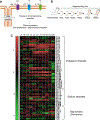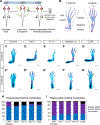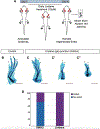Precise control of ion channel and gap junction expression is required for patterning of the regenerating axolotl limb
- PMID: 33200809
- PMCID: PMC8796139
- DOI: 10.1387/ijdb.200114jw
Precise control of ion channel and gap junction expression is required for patterning of the regenerating axolotl limb
Abstract
Axolotls and other salamanders have the capacity to regenerate lost tissue after an amputation or injury. Growth and morphogenesis are coordinated within cell groups in many contexts by the interplay of transcriptional networks and biophysical properties such as ion flows and voltage gradients. It is not, however, known whether regulators of a cell's ionic state are involved in limb patterning at later stages of regeneration. Here we manipulated expression and activities of ion channels and gap junctions in vivo, in axolotl limb blastema cells. Limb amputations followed by retroviral infections were performed to drive expression of a human gap junction protein Connexin 26 (Cx26), potassium (Kir2.1-Y242F and Kv1.5) and sodium (NeoNav1.5) ion channel proteins along with EGFP control. Skeletal preparation revealed that overexpressing Cx26 caused syndactyly, while overexpression of ion channel proteins resulted in digit loss and structural abnormalities compared to EGFP expressing control limbs. Additionally, we showed that exposing limbs to the gap junction inhibitor lindane during the regeneration process caused digit loss. Our data reveal that manipulating native ion channel and gap junction function in blastema cells results in patterning defects involving the number and structure of the regenerated digits. Gap junctions and ion channels have been shown to mediate ion flows that control the endogenous voltage gradients which are tightly associated with the regulation of gene expression, cell cycle progression, migration, and other cellular behaviors. Therefore, we postulate that mis-expression of these channels may have disturbed this regulation causing uncoordinated cell behavior which results in morphological defects.
Conflict of interest statement
The authors declare no conflicts of interest.
Figures




Similar articles
-
Different ionic selectivities for connexins 26 and 32 produce rectifying gap junction channels.Biophys J. 1999 Dec;77(6):2968-87. doi: 10.1016/S0006-3495(99)77129-8. Biophys J. 1999. PMID: 10585920 Free PMC article.
-
Sall4 regulates downstream patterning genes during limb regeneration.Dev Biol. 2024 Nov;515:151-159. doi: 10.1016/j.ydbio.2024.07.015. Epub 2024 Jul 25. Dev Biol. 2024. PMID: 39067503
-
BMP-2 functions independently of SHH signaling and triggers cell condensation and apoptosis in regenerating axolotl limbs.BMC Dev Biol. 2010 Feb 12;10:15. doi: 10.1186/1471-213X-10-15. BMC Dev Biol. 2010. PMID: 20152028 Free PMC article.
-
Gating of Connexin Channels by transjunctional-voltage: Conformations and models of open and closed states.Biochim Biophys Acta Biomembr. 2018 Jan;1860(1):22-39. doi: 10.1016/j.bbamem.2017.04.028. Epub 2017 May 2. Biochim Biophys Acta Biomembr. 2018. PMID: 28476631 Free PMC article. Review.
-
Pannexin channels are not gap junction hemichannels.Channels (Austin). 2011 May-Jun;5(3):193-7. doi: 10.4161/chan.5.3.15765. Epub 2011 May 1. Channels (Austin). 2011. PMID: 21532340 Free PMC article. Review.
Cited by
-
Cell Systems Bioelectricity: How Different Intercellular Gap Junctions Could Regionalize a Multicellular Aggregate.Cancers (Basel). 2021 Oct 22;13(21):5300. doi: 10.3390/cancers13215300. Cancers (Basel). 2021. PMID: 34771463 Free PMC article.
-
Impact of Membrane Voltage on Formation and Stability of Human Renal Proximal Tubules in Vitro.ACS Biomater Sci Eng. 2022 Mar 14;8(3):1239-1246. doi: 10.1021/acsbiomaterials.1c01163. Epub 2022 Feb 14. ACS Biomater Sci Eng. 2022. PMID: 35157435 Free PMC article.
-
Voltage-gated sodium channel scn8a is required for innervation and regeneration of amputated adult zebrafish fins.Proc Natl Acad Sci U S A. 2022 Jul 12;119(28):e2200342119. doi: 10.1073/pnas.2200342119. Epub 2022 Jul 6. Proc Natl Acad Sci U S A. 2022. PMID: 35867745 Free PMC article.
-
Potassium channel-driven bioelectric signalling regulates metastasis in triple-negative breast cancer.EBioMedicine. 2022 Jan;75:103767. doi: 10.1016/j.ebiom.2021.103767. Epub 2021 Dec 18. EBioMedicine. 2022. PMID: 34933180 Free PMC article.
-
Nociceptor sodium channels shape subthreshold phase, upstroke, and shoulder of action potentials.J Gen Physiol. 2025 Mar 3;157(2):e202313526. doi: 10.1085/jgp.202313526. Epub 2025 Jan 21. J Gen Physiol. 2025. PMID: 39836077 Free PMC article.
References
-
- ADAMS DS, MASI A & LEVIN M (2007). H+ pump-dependent changes in membrane voltage are an early mechanism necessary and sufficient to induce Xenopus tail regeneration. Development, 134: 1323–35. - PubMed
-
- BATES E (2015). Ion Channels in Development and Cancer. Annu Rev Cell Dev Biol, 31: 231–47. - PubMed
Publication types
MeSH terms
Substances
Grants and funding
LinkOut - more resources
Full Text Sources
Miscellaneous

